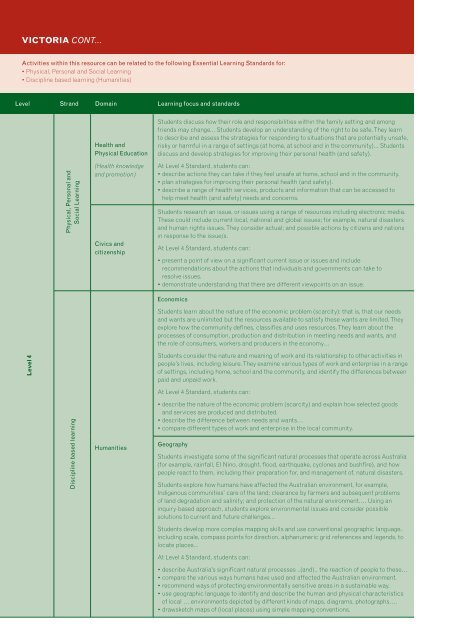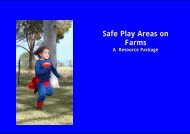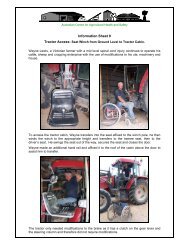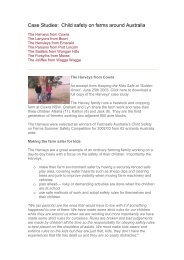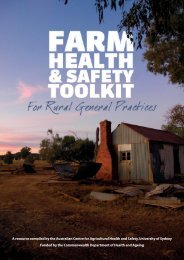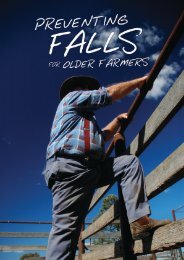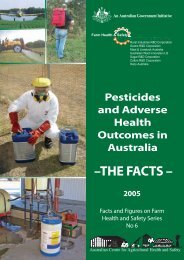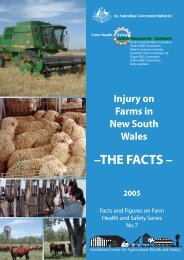Ripper ii Educational resource for primary schools - Australian ...
Ripper ii Educational resource for primary schools - Australian ...
Ripper ii Educational resource for primary schools - Australian ...
Create successful ePaper yourself
Turn your PDF publications into a flip-book with our unique Google optimized e-Paper software.
VICTORIA CONT...Activities within this <strong>resource</strong> can be related to the following Essential Learning Standards <strong>for</strong>:• Physical, Personal and Social Learning• Discipline based learning (Humanities)Level Strand Domain Learning focus and standardsHealth andPhysical EducationStudents discuss how their role and responsibilities within the family setting and amongfriends may change... Students develop an understanding of the right to be safe. They learnto describe and assess the strategies <strong>for</strong> responding to situations that are potentially unsafe,risky or harmful in a range of settings (at home, at school and in the community)... Studentsdiscuss and develop strategies <strong>for</strong> improving their personal health (and safety).Physical, Personal andSocial Learning(Health knowledgeand promotion)Civics andcitizenshipAt Level 4 Standard, students can:• describe actions they can take if they feel unsafe at home, school and in the community.• plan strategies <strong>for</strong> improving their personal health (and safety).• describe a range of health services, products and in<strong>for</strong>mation that can be accessed tohelp meet health (and safety) needs and concerns.Students research an issue, or issues using a range of <strong>resource</strong>s including electronic media.These could include current local, national and global issues; <strong>for</strong> example, natural disastersand human rights issues. They consider actual; and possible actions by citizens and nationsin response to the issue/s.At Level 4 Standard, students can:• present a point of view on a significant current issue or issues and includerecommendations about the actions that individuals and governments can take toresolve issues.• demonstrate understanding that there are different viewpoints on an issue.EconomicsStudents learn about the nature of the economic problem (scarcity): that is, that our needsand wants are unlimited but the <strong>resource</strong>s available to satisfy these wants are limited. Theyexplore how the community defines, classifies and uses <strong>resource</strong>s. They learn about theprocesses of consumption, production and distribution in meeting needs and wants, andthe role of consumers, workers and producers in the economy…Level 4Students consider the nature and meaning of work and its relationship to other activities inpeople’s lives, including leisure. They examine various types of work and enterprise in a rangeof settings, including home, school and the community, and identify the differences betweenpaid and unpaid work.At Level 4 Standard, students can:Discipline based learningHumanities• describe the nature of the economic problem (scarcity) and explain how selected goodsand services are produced and distributed.• describe the difference between needs and wants…• compare different types of work and enterprise in the local community.GeographyStudents investigate some of the significant natural processes that operate across Australia(<strong>for</strong> example, rainfall, El Nino, drought, flood, earthquake, cyclones and bushfire), and howpeople react to them, including their preparation <strong>for</strong>, and management of, natural disasters.Students explore how humans have affected the <strong>Australian</strong> environment, <strong>for</strong> example,Indigenous communities’ care of the land; clearance by farmers and subsequent problemsof land degradation and salinity; and protection of the natural environment…. Using aninquiry-based approach, students explore environmental issues and consider possiblesolutions to current and future challenges...Students develop more complex mapping skills and use conventional geographic language,including scale, compass points <strong>for</strong> direction, alphanumeric grid references and legends, tolocate places...At Level 4 Standard, students can:22• describe Australia’s significant natural processes ..(and).. the reaction of people to these…• compare the various ways humans have used and affected the <strong>Australian</strong> environment.• recommend ways of protecting environmentally sensitive areas in a sustainable way.• use geographic language to identify and describe the human and physical characteristicsof local … environments depicted by different kinds of maps, diagrams, photographs….• drawsketch maps of (local places) using simple mapping conventions.


